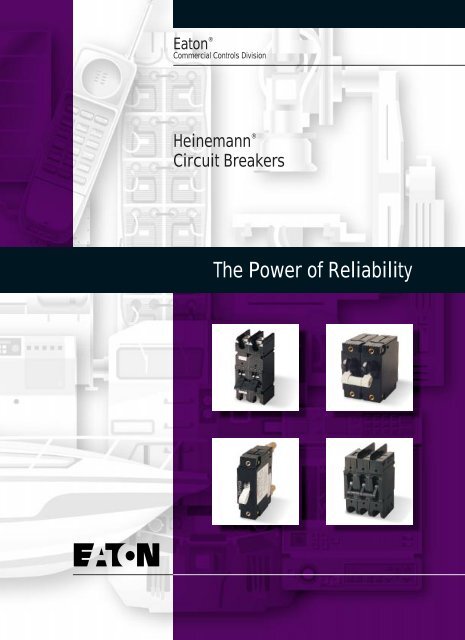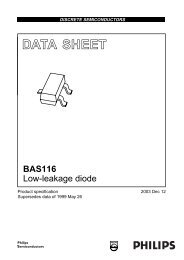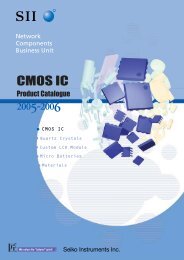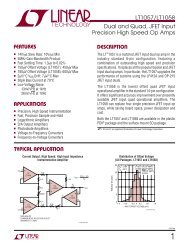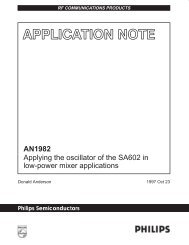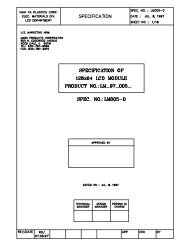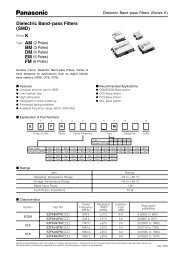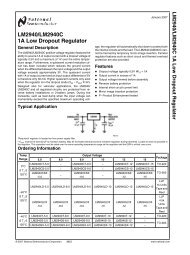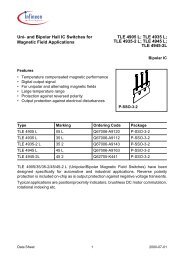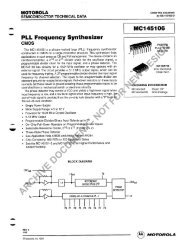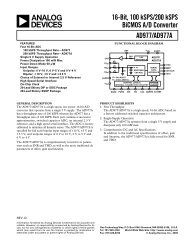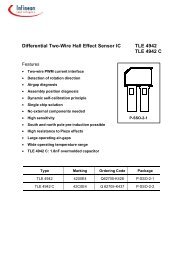The Power of Reliability - Heinemann Electric Canada Ltd.
The Power of Reliability - Heinemann Electric Canada Ltd.
The Power of Reliability - Heinemann Electric Canada Ltd.
Create successful ePaper yourself
Turn your PDF publications into a flip-book with our unique Google optimized e-Paper software.
Eaton ®<br />
Commercial Controls Division<br />
<strong>Heinemann</strong> ®<br />
Circuit Breakers<br />
<strong>The</strong> <strong>Power</strong> <strong>of</strong> <strong>Reliability</strong>
<strong>Heinemann</strong> Circuit Breakers<br />
HEINEMANN ® Circuit Breaker Know-How<br />
Our know-how goes back a long way. For example, the first<br />
magnetic circuit breaker was patented by HEINEMANN in 1932.<br />
Until then, circuit breakers tripped when an overload heated an<br />
internal element. But on hot days, or when located near heatgenerating<br />
equipment, they sometimes tripped unnecessarily.<br />
This was known as nuisance tripping.<br />
HEINEMANN ended this nuisance. Its new magnetic circuit breaker<br />
was tripped by a solenoid, taking advantage <strong>of</strong> the overcurrent that<br />
occurs during a fault. Ambient heat no longer mattered. For starting<br />
inrushes, delays were added.<br />
Today, HEINEMANN <strong>of</strong>fers product designers the broadest range<br />
<strong>of</strong> magnetic circuit breakers, with ratings from 0.01 amp to 1200<br />
amps. If this guide doesn’t contain the information you need,<br />
please ask us for it by phone, fax or letter.<br />
Over 100 Years <strong>of</strong> Excellence<br />
When HEINEMANN was founded in 1888, the electric light had<br />
been invented by Thomas Edison only nine years earlier. <strong>The</strong> first<br />
commercial electric railroad<br />
started in 1884 in<br />
Cleveland. And AC<br />
electricity was first used to<br />
light up “Main Street” in<br />
Great Barrington,<br />
Massachusetts in 1886.<br />
Gas was widely used for<br />
home, business and street<br />
lighting in the bigger cities.<br />
Everywhere else, people<br />
used oil lamps or candles.<br />
Only the adventuresome<br />
even considered electric<br />
lighting for their homes or<br />
businesses. For example,<br />
when the White House<br />
was electrified in 1891,<br />
President Benjamin<br />
Harrison refused to allow<br />
his children to turn the<br />
lights on or <strong>of</strong>f. He was<br />
afraid they would electrocute<br />
themselves. It was<br />
a task reserved for the<br />
servants.<br />
Two years earlier, a locksmith named George HEINEMANN,<br />
believing there was a future in electricity, opened one <strong>of</strong> the first<br />
electrical contracting companies in the nation. If you lived in the<br />
Philadelphia area and wanted electric lights or needed repairs on<br />
an electric motor, you might have called upon HEINEMANN.<br />
Unlike today, the supplies used by electrical installers were not<br />
available at the local store, or anywhere else for that matter.<br />
Contractors like George had to make their own.<br />
Feb. 2, 1932 1,843,351<br />
Two key parts <strong>of</strong> any installation were the knife switch for ON/OFF<br />
control and the fuse-cutout, which protected the circuit from the<br />
danger <strong>of</strong> overloads or short circuits.<br />
In 1915 the company withdrew from the contracting business and<br />
concentrated on the manufacture <strong>of</strong> electrical protection devices.<br />
George HEINEMANN retired in 1917.<br />
In 1927, research took a new direction at HEINEMANN, one that it<br />
follows to this day. Development began on an automatic protective<br />
device called a circuit breaker.<br />
In the 1930s, HEINEMANN developed and put into production a<br />
radically different kind <strong>of</strong> circuit breaker, the magnetic breaker.<br />
Until then, circuit breakers depended on the heat caused by an<br />
electrical overload to trip the circuit open. But too <strong>of</strong>ten, such<br />
breakers tripped unnecessarily, such as on a hot day or when<br />
installed near heat generating machinery. A magnetic breaker<br />
trips when a magnetic field within the breaker increases due to<br />
increased current flow caused by the overload. Heat plays no part<br />
in its operation, putting an end to heat induced nuisance tripping.<br />
During the early 1940s, HEINEMANN circuit breakers went to war.<br />
Widespread use <strong>of</strong> electronic equipment in World War II such as<br />
radio and radar, as well as more conventional electric equipment,<br />
led to the installation <strong>of</strong><br />
HEINEMANN circuit breakers<br />
in every kind <strong>of</strong> fighting<br />
ship from PT boats to<br />
battleships as well as in airplanes,<br />
radar stations and<br />
communications centers.<br />
In the 1940s, the company<br />
expanded rapidly to serve<br />
the growing industrial and<br />
consumer electronics market.<br />
To better serve this<br />
market in other countries,<br />
HEINEMANN established<br />
foreign affiliates.<br />
Today, HEINEMANN is the<br />
leading manufacturer <strong>of</strong><br />
“OEM” circuit breakers.<br />
Applications include computers,<br />
healthcare equipment,<br />
pleasure boats and<br />
naval vessels, communications<br />
systems, electric<br />
locomotives and space<br />
vehicles.<br />
During its 100-plus years, HEINEMANN has earned a reputation for<br />
innovative designs and high quality. Where overload protection is<br />
required, we may sound like a winning football coach when we say,<br />
“We’ll match our defensive line against anybody’s.”
<strong>Heinemann</strong> Circuit Breakers<br />
For the Widest Selection <strong>of</strong> Circuit Protection, from 0.01 to 1200 Amperes,<br />
Look to HEINEMANN<br />
Circuit Breaker Selection Guide<br />
PS1<br />
Before You Make a Decision<br />
Choosing the right circuit protector for a particular application shouldn’t be left to chance. While the selection<br />
process may range from simple to complex, this handy guide will get you started. HEINEMANN technical<br />
assistance engineers are ready to help you make the final decisions wisely and economically.<br />
Refer to pages 8 and 9 for internal circuits regarding protective and control<br />
applications.<br />
Refer to pages 10 and 11 for construction codes.<br />
HEINEMANN <strong>of</strong>fers the widest selection <strong>of</strong> overcurrent protectors for end products<br />
J/S<br />
as diverse as electronic data processing and industrial air conditioning to marine craft<br />
and military equipment. We are also able to supply breakers that serve as control<br />
functions, giving you the performance <strong>of</strong> an ON/OFF switch and a circuit breaker,<br />
all in one economical and compact unit.<br />
DM/S<br />
This condensed guide will assist you with product selection, helping you review<br />
options for your specific application. You may also call one <strong>of</strong> our applications<br />
engineers to discuss your particular requirement. We may have<br />
already solved your particular problem for someone else. If not,<br />
we’ll develop a circuit protector to suit your needs.<br />
AM-MIL and CD/CF-MIL (M-55629)<br />
KD1<br />
NOTICE!<br />
“<strong>The</strong> use <strong>of</strong> Eaton Corporation, Commercial<br />
Controls Division apparatus should be in<br />
accordance with the provisions <strong>of</strong> the National<br />
<strong>Electric</strong>al Code, UL and/or other local, military<br />
or industry standards that are pertinent to<br />
the particular end use. Installation or use<br />
not in accordance with these codes and<br />
standards could be hazardous to personnel<br />
and/or equipment.”<br />
AM/S<br />
CD - CE - CF<br />
GH<br />
GJ<br />
GJ1P<br />
1200<br />
700 600 500 400 300<br />
200<br />
100 90<br />
80<br />
70<br />
60<br />
50<br />
40<br />
30<br />
20<br />
15<br />
10<br />
0<br />
1
Quick Guide<br />
Series PS1<br />
Series KD1<br />
Fuse-switch provides ON/OFF control and fuse protection<br />
in a single low-cost component. Its use<br />
eliminates a hole and interconnecting wiring and<br />
makes it easy to re-fuse from the front panel. It<br />
accepts standard 1/4" diameter by 1-1/4" fuses.<br />
An adapter is available for 5 mm x 20 mm fuses.<br />
Can be supplied for NO or NC operation.<br />
A low cost pushbutton supplementary protector<br />
for electrical equipment, designed to fit in a standard<br />
5/8" round or “D” fuseholder panel cutout.<br />
Resettable at up to 1000% <strong>of</strong> its rated current<br />
from 2.5A through 15A, 500% from 0.25A through<br />
2A. Slide-on retaining ring included.<br />
Applications<br />
Consumer and industrial products that would<br />
otherwise use a separate ON/OFF switch and fuse<br />
holder.<br />
Consumer and industrial products, <strong>of</strong>fice machines,<br />
appliances, power supplies, convenience outlets,<br />
electronic games.<br />
No. <strong>of</strong> Poles<br />
1<br />
1<br />
Current<br />
Ratings<br />
Determined by choice <strong>of</strong> fuse. To 20A<br />
0.25 – 15A<br />
Max.<br />
Voltage<br />
120V AC @ 20A<br />
250V AC @ 15A<br />
32V DC @ 20A<br />
240V AC @ 15A<br />
250V AC, 50/60 Hz<br />
50V AC up to 10A<br />
32V DC @ 15A<br />
50V DC @ 10A<br />
Interrupting<br />
Capacity<br />
1000A @ 250V AC, 50/60 Hz<br />
200A @ 32V DC and 50V DC per UL Standard<br />
1077 testing procedures<br />
Agency<br />
Recognition or<br />
Approval<br />
UL recognized<br />
CSA certified<br />
SEV approved<br />
UL recognized (Std. 1077)<br />
CSA certified<br />
VDE approved<br />
SEV approved<br />
Dimensions<br />
2.35<br />
(59.69)<br />
1.406<br />
(35.71)<br />
0.25<br />
(6.35)<br />
0.75<br />
(19.05)<br />
Dia.<br />
0.620<br />
(15.75)<br />
Dia.<br />
0.375<br />
(9.53)<br />
0.625<br />
(15.88)<br />
Dia.<br />
0.75<br />
(19.05)<br />
Dia.<br />
2
Quick Guide<br />
Series J/S<br />
Series DM/S<br />
Compact, lightweight, moderately priced circuit<br />
breaker for single- or multi-pole OEM applications.<br />
Also available with snap-in mounting or rocker<br />
handles. Sealed mount models are also available,<br />
single-pole only. Series J/S breakers are suitable<br />
for domestic or world-market applications.<br />
Models also available for marine applications.<br />
DM/S circuit breakers snap easily into a standard<br />
35 mm DIN rail and may be mounted or detected<br />
without moving other breakers on the rail. <strong>The</strong>y<br />
provide all the advantages <strong>of</strong> hydraulic-magnetic<br />
circuit protection including freedom from heatinduced<br />
nuisance tripping and a wide choice <strong>of</strong><br />
time delay ranges. Available with auxiliary SPDT<br />
switch for alarm or control purposes.<br />
OEM (power supplies, medical-electronic equipment,<br />
control systems, <strong>of</strong>fice and EDP equipment),<br />
control panels, marine equipment, field<br />
instrumentation.<br />
OEM (industrial equipment, process control systems<br />
and telecommunications).<br />
1 to 6<br />
1 to 4<br />
0.02 – 50A<br />
0.02 – 50A<br />
250V AC (30A maximum)<br />
65V DC (50A maximum)<br />
80V DC (15A maximum)<br />
250V, 50/60 or 400 Hz<br />
277V, 50/60 Hz, 1-ph<br />
480V, 50/60 Hz, 3-ph “Y”<br />
65V DC<br />
1000A<br />
5000A with back-up fusing<br />
1000A<br />
5000A with back-up fusing<br />
UL recognized (Std. 1077)<br />
CSA certified<br />
SEV approved<br />
IEC approved<br />
VDE approved<br />
UL listed (Std. UL489)<br />
UL recognized (Std. 1077)<br />
CSA certified<br />
SEV approved<br />
IEC approved<br />
VDE approved<br />
1.555<br />
(39.50)<br />
1.50<br />
(38.1)<br />
3.205<br />
(81.41)<br />
1.50<br />
(38.1)<br />
2.00<br />
(50.8)<br />
4.134<br />
(105.00)<br />
3
Quick Guide<br />
Series AM-MIL<br />
Series AM/S<br />
Series CD, CE, CF<br />
HEINEMANN Series AM-MIL<br />
breakers are specifically built and<br />
tested in accordance with the<br />
requirements <strong>of</strong> MIL-C-55629.<br />
Fungus and moisture resistance is<br />
provided by treating all ferrous<br />
parts with a special finish, and by<br />
using special springs and inherently<br />
fungus-resistant phenolic<br />
cases, covers and handles.<br />
Series AM/S “world class” circuit<br />
breakers meet International<br />
Standard IEC 380 and German<br />
Standard VDE 0730. <strong>The</strong> 8 mm<br />
spacing requirement and dielectricwithstand<br />
specification are incorporated<br />
into the standard AM breaker<br />
housing without changes in size,<br />
thereby eliminating mounting<br />
procedure modifications or the<br />
need for adapter plates.<br />
Priced considerably lower than<br />
competitive E-frame breakers, the<br />
Series CF is the most compact and<br />
versatile circuit breaker available<br />
for equipment and branch circuit<br />
protection. Single- and multi-pole<br />
models are available in a wide<br />
range <strong>of</strong> standard ratings.<br />
Applications<br />
OEM (data processing equipment,<br />
mobile applications, military<br />
equipment subject to humid,<br />
tropical environments).<br />
OEM (data processing equipment,<br />
telecommunications, mobile applications,<br />
humid environments).<br />
Panelboards, switchboards,<br />
branch circuits, EDP equipment,<br />
machine tools, environmental<br />
systems, single- and three-phase<br />
applications.<br />
No. <strong>of</strong> Poles<br />
1 to 4<br />
1 to 8<br />
1 to 6<br />
Current<br />
Ratings<br />
0.020 – 50A (AC and DC)<br />
0.020 – 100A (AC and DC)<br />
0.01 – 100A (AC)<br />
0.01 – 125A (DC)<br />
Max.<br />
Voltage<br />
240V 50/60 Hz<br />
240V 400 Hz<br />
50V DC<br />
250V, 50/60 Hz or 400 Hz<br />
277V, 50/60 Hz 1-ph<br />
80 – 125V DC<br />
480V, 50/60 Hz<br />
3-ph “Y”<br />
240V, 50/60 or 400 Hz<br />
480V, 1- and 3-ph<br />
125V DC<br />
600V, 3-ph<br />
160V DC<br />
Interrupting<br />
Capacity<br />
2000A @ 50V DC and<br />
120V AC, 60 Hz<br />
1500A @ 120V AC, 400 Hz<br />
1000A @ 240V AC, 60 and<br />
400 Hz<br />
10,000A (120V AC/80V DC)<br />
5000A @ 250V AC with back-up<br />
fusing<br />
10,000A @ 120V AC<br />
7500A @ 120/240V AC<br />
50/60 Hz, 240V AC, 50/60 Hz<br />
5000A @ 125V DC<br />
25,000A @ 65V DC<br />
Agency<br />
Recognition<br />
or Approval<br />
Not required for QPL items<br />
UL recognized (Std. 1077)<br />
CSA certified<br />
VDE (pending)<br />
UL listed (Std. UL489)<br />
UL1500 (pending)<br />
240V, 50/60 Hz and 125V DC<br />
UL listed<br />
Others: UL Recognized, CSA certified<br />
Dimensions<br />
1.981<br />
(50.32)<br />
0.75<br />
(19.05)<br />
2.000<br />
(50.80)<br />
0.75<br />
(19.05)<br />
2.609<br />
(66.27)<br />
1.026<br />
(26.06)<br />
2.50<br />
(63.50)<br />
2.50<br />
(63.50)<br />
5.80<br />
(147.32)<br />
4
Quick Guide<br />
Series GH<br />
Series GJ<br />
Series GJ1P<br />
This rugged EH-frame breaker<br />
<strong>of</strong>fers all the advantages <strong>of</strong> a<br />
completely magnetic, three-pole<br />
breaker with 10,000A interrupting<br />
capacity for a less costly, smaller<br />
circuit breaker. Compact, environmentally<br />
stable. To 100A at 480V<br />
AC and 250V DC.<br />
Motor controls, air conditioning,<br />
electric heating, computer<br />
mainframes, transportation, indoor<br />
or outdoor installations.<br />
1 to 4<br />
0.5 – 100A (AC)<br />
0.5 – 100A (DC)<br />
480V, 50/60 Hz<br />
750V DC<br />
600V AC<br />
Where space is at a premium and<br />
current capacity up to 250A is<br />
called for, the Series GJ is the<br />
answer. Available in 1, 2 or 3 pole<br />
models, it is especially suitable for<br />
panelboards, service entrances and<br />
electric vehicles.<br />
Commercial, industrial, and<br />
residential service — entrance or<br />
panelboard applications, lighting,<br />
appliance, transformer, electric<br />
vehicles, EDP power supplies,<br />
heating, air conditioning and<br />
electronic circuit protection.<br />
1 to 6<br />
100 – 250A<br />
240V, 50/60 Hz<br />
125/250V DC<br />
GJ1P parallel-pole breakers<br />
incorporate Precision Current<br />
Equalization (PCE) to automatically<br />
distribute current sensing<br />
elements. PCE thereby minimizes<br />
nuisance tripping which can occur<br />
with conventional parallel-pole<br />
breakers. An optional shunt<br />
permits metering <strong>of</strong> current. Since<br />
shunt output is only 25 mV, lightgauge<br />
wiring can be used between<br />
shunt and meter.<br />
Telecommunications and<br />
transportation equipment.<br />
1<br />
100 – 1200A (DC)<br />
160V DC<br />
14,000A (AC)<br />
10,000A (DC)<br />
18,000A @ 240V, 50/60 Hz<br />
10,000A @ 125/250V DC<br />
14,000A @ 160V DC<br />
25,000A @ 65V DC<br />
10,000A @ 160V DC<br />
25,000A @ 65V DC<br />
UL recognized (AC)<br />
(3 pole)<br />
480V AC<br />
15 – 100A<br />
240V, 50/60 Hz and<br />
125/250V DC: UL listed<br />
160V DC: UL listed<br />
3.375<br />
(85.73)<br />
4.125<br />
(104.78)<br />
3.188<br />
(80.98)<br />
3.0<br />
(76.20)<br />
4.5<br />
(114.3)<br />
6.0<br />
(152.40)<br />
7.125<br />
(180.97)<br />
10.375<br />
(263.52)<br />
4.452<br />
(113.08)<br />
5
Precise Overload Protection — with HEINEMANN Hydraulic-Magnetic Circuit Breakers<br />
Heat-Induced Nuisance Tripping Eliminated<br />
HEINEMANN hydraulic-magnetic circuit breakers <strong>of</strong>fer three major<br />
advantages over thermal devices.<br />
1. Elimination <strong>of</strong> nuisance tripping caused by high ambient<br />
temperatures in or near the installation. <strong>The</strong> breaker<br />
responds only to current variations, not to temperature<br />
change.<br />
2. Assurance that 100% <strong>of</strong> the rated current will be carried.<br />
<strong>The</strong>re is no such assurance with thermal devices, which<br />
may fail to carry rated current when subjected to abovenormal<br />
ambient temperatures. A HEINEMANN breaker rated<br />
at 20A, for example, will sustain 20A, even at elevated<br />
temperatures. Derating and other forms <strong>of</strong> temperature<br />
compensation are unnecessary.<br />
3. Immediate reset. Since there are no thermal elements, heat<br />
build-up is not a factor. <strong>The</strong>refore, no “cooling <strong>of</strong>f” period<br />
is required after fault interruption.<br />
Time Delay Eliminates Breaker Tripping Due to<br />
Transient Current Surges<br />
Elimination <strong>of</strong> transient current surges as a cause <strong>of</strong> nuisance<br />
tripping is accomplished through the creation <strong>of</strong> a controlled<br />
time delay. In any installation where a power supply or compressor<br />
motor is on the line, an inrush <strong>of</strong> current occurs when<br />
the equipment is first turned on. <strong>The</strong> bigger the equipment, the<br />
larger the surge. Although inrush surges are, in fact, transient<br />
overloads, they usually pose no threat <strong>of</strong> damage to the line or<br />
the equipment. So, it is not necessary or even desirable to<br />
interrupt the power when they occur.<br />
<strong>The</strong> hydraulically-controlled time-delay mechanism <strong>of</strong> a<br />
HEINEMANN breaker eliminates nuisance tripping without<br />
reducing overload protection. <strong>The</strong> delay is inversely proportional<br />
to the overload; response is quicker on large overloads,<br />
where greater potential danger exists, and slower<br />
on small overloads. Except in special high-inrush models,<br />
heavy overload and short-circuit currents <strong>of</strong> greater than 10<br />
times the breaker’s rating provide instantaneous response.<br />
(An instantaneous-trip breaker is available for use on, for<br />
example, modern medical and communication equipment,<br />
which cannot tolerate even brief overloads.)<br />
For added protection, the time-delay is self-adjusting to ambient<br />
temperature conditions. At high ambients, where the overload<br />
tolerance <strong>of</strong> most circuits is lowered, the viscosity <strong>of</strong> the special<br />
fluid in the breaker’s dashpot is lessened, and the time-delay<br />
response is thereby shortened. At low temperatures, the response<br />
is correspondingly longer to allow for cold equipment startups.<br />
<strong>The</strong> Hydraulic-Magnetic Principle (how the breaker works)<br />
1. <strong>The</strong> HEINEMANN hydraulic-magnetic<br />
circuit breaker operates on load-currentproduced<br />
magnetic flux variation in a<br />
solenoid. <strong>The</strong> coil is wound around a<br />
hermetically sealed, non-magnetic tube<br />
containing a spring-loaded, movable<br />
iron core and a silicone liquid fill. With<br />
the load current either at or below the<br />
breaker’s nominal rating, the magnetic<br />
flux is <strong>of</strong> insufficient strength to move<br />
the core, and it remains at the end <strong>of</strong> the<br />
tube opposite the armature.<br />
2. On an overload, the magnetic flux force<br />
increases, pulling the iron core into the<br />
coil toward the armature end <strong>of</strong> the<br />
tube. This core insertion reduces the<br />
reluctance <strong>of</strong> the magnetic circuit and<br />
further increases the strength <strong>of</strong> the<br />
magnetic field. <strong>The</strong> silicone liquid regulates<br />
the core’s speed <strong>of</strong> travel, creating<br />
a controlled trip delay that is inversely<br />
proportional to the magnitude <strong>of</strong> the<br />
overload. If the overload subsides before<br />
the core reaches the pole piece, the core<br />
returns to its original position, and the<br />
breaker does not trip. (For non-delay<br />
applications, the breaker is modified to<br />
omit the intentional delay.)<br />
3. When the magnetic flux reaches a predetermined<br />
value, the armature is attracted<br />
to the pole piece and the breaker trips.<br />
(<strong>The</strong> breaker may trip before the core<br />
reaches the pole piece if the critical flux<br />
value is achieved first.) On very heavy<br />
overloads or short circuits, the flux produced<br />
by the coil above, regardless <strong>of</strong><br />
core position, is sufficient to pull in the<br />
armature. This circuit interruption occurs<br />
with no intentional delay — a highly<br />
desirable response characteristic.<br />
6
Current Rating and Time Delay is Supplied to User Specification<br />
<strong>The</strong> current rating <strong>of</strong> a HEINEMANN breaker is determined by<br />
the number <strong>of</strong> ampere-turns in the load-sensing coil. By altering<br />
the number <strong>of</strong> turns and wire size, HEINEMANN can provide a<br />
breaker <strong>of</strong> virtually any rating within the unit’s overall range. It<br />
is even possible to specify current ratings in fractional values.<br />
Time-delay characteristics can be precisely matched to the<br />
requirements <strong>of</strong> the application. A choice <strong>of</strong> many time-delay<br />
curves, including non-time-delay and high-inrush protection, is<br />
available on most single- and multi-pole breakers.<br />
A Look Inside<br />
1. Broad Selection <strong>of</strong> Terminal Styles<br />
Pressure connector, threaded stud, hook, bus, plug-in and<br />
quick-connect terminals (with holes for optional soldering)<br />
are available.<br />
2. Self-Cleaning Contacts<br />
Sliding pivot point causes a wiping action across the contacts<br />
each time a breaker is switched. This cleaning motion<br />
helps keep surface resistance low, extending contact life.<br />
(Contacts are made <strong>of</strong> silver alloy for minimal wattage loss.)<br />
3. Efficient Blowout Grid<br />
U-shaped grid plates quickly draw out, fragment and extinguish<br />
contact arc. Charring and pitting are minimized.<br />
4. Sturdy Toggle and Latch<br />
Strong, durable and highly efficient. Latch is shockresistant,<br />
yet provides very fast operation. Trip-free construction<br />
makes it impossible to hold the breaker closed<br />
against a fault. (Even when handle is held in ON position,<br />
contacts trip free <strong>of</strong> fault condition.)<br />
5. Balanced Armature<br />
Counterbalanced armature design helps prevent mechanical<br />
tripping caused by shock and vibration. Meets MIL-STD-<br />
202 requirements.<br />
6. Two-Position Switching<br />
Two handle positions, ON and OFF (no ambiguous “reset”<br />
position). After fault clearance, simply snap the handle<br />
back to ON.<br />
7. Load-Sensing Coil<br />
Magnetic unit measures current, not temperature, making it<br />
unnecessary to derate for high-ambient service. Coil will<br />
carry 100% rated load as specified in the appropriate<br />
response curve. (See in-depth discussion, page 6.)<br />
8. Fungus-Resistant Case<br />
Circuit breakers are housed in special plastic casings that<br />
significantly reduce fungal growth and contamination.<br />
7
Internal Circuits for Protective and Control Applications<br />
Circuit breakers are <strong>of</strong>ten overlooked as control elements in<br />
industrial circuit design. <strong>The</strong> seven constructions outlined below<br />
illustrate the broad range <strong>of</strong> possibilities currently available on<br />
standard products. When used singly or in combination, these<br />
special circuits allow breakers to become more meaningful<br />
members <strong>of</strong> modern control systems. Other designs are also<br />
available for more unusual applications. Consult HEINEMANN<br />
for assistance.<br />
Line<br />
Load<br />
Relay<br />
Trip<br />
Line<br />
Relay-Trip<br />
Relay<br />
Trip<br />
Load<br />
Series-Trip<br />
In this conventional circuit breaker configuration, the sensing<br />
coil and contacts are wired in series with the line and load<br />
terminals.<br />
This standard design is used in breakers that see duty as main<br />
switches and as short circuit protectors in supply-voltage wiring.<br />
<strong>The</strong>y also provide overload protection for a wide variety <strong>of</strong> equipment<br />
and components such as transformers, solenoids and motors.<br />
<strong>The</strong> relay-trip design provides a tripping coil that is actuated<br />
from a remote device (any control switch or even another circuit<br />
breaker). Because the relay-trip coil is isolated from the contact<br />
circuit, either control current or voltage may be employed to trip<br />
the breaker.<br />
Relay-trip breakers are available with voltage-sensing or currentsensing<br />
coils, with or without intentional trip delay. (Non-delay is<br />
standard and will be provided unless otherwise specified.)<br />
Voltage-sensing coils are usually designed for non-continuous duty,<br />
and provision must be made for de-energizing when the contacts<br />
are opened. Continuous-duty voltage coils, within certain limitations,<br />
can also be supplied. Consult HEINEMANN for parameters.<br />
It is important to note that the current or voltage ratings <strong>of</strong> both<br />
coil and contact circuits should be specified separately.<br />
Line<br />
Line<br />
Relay<br />
Trip<br />
Load<br />
Relay<br />
Trip<br />
Load<br />
Dual Rating<br />
This construction employs two concentrically wound sensing<br />
coils to provide two discrete current ratings in the same breaker.<br />
This permits the use <strong>of</strong> a single breaker to protect equipment<br />
designed to operate at two different current levels, or two<br />
different supply voltages, such as 6/12V DC or 110/220V<br />
50/60 Hz. Certain limitations may govern application; consult<br />
HEINEMANN for assistance.<br />
Load<br />
Dual Controlled (DuCon)<br />
In applications where over-current conditions and a separate<br />
(unrelated) voltage signal must be sensed, the general practice<br />
has been to use a two-pole breaker — one pole a series-trip and<br />
the other a relay- or shunt-trip.<br />
For applications where space does not permit the use <strong>of</strong> a<br />
two-pole unit, the DuCon adds a small non-continuous duty<br />
voltage-sensing coil to a one-pole series-trip breaker, using either<br />
relay-trip circuitry for energizing from a source other than line<br />
voltage, or shunt/tap circuitry for operation on the same power<br />
source as that used in the overload protection circuit.<br />
8
Internal Circuits<br />
Line<br />
Line<br />
C<br />
Load<br />
or Tap<br />
NO<br />
NC<br />
Shunt/Tap<br />
Shunt<br />
or Load<br />
<strong>The</strong> shunt/tap design allows remote tripping through appropriate<br />
circuit-closing contacts in a remote device. (On breakers rated 1A<br />
and below, the design can also be used to raise the breaker’s trip<br />
point by shunting with an external resistor between the load and<br />
shunt terminals.) Unlike relay-trip models, shunt/tap breakers<br />
operate on the line voltage, rather than from a secondary power<br />
source.<br />
It is important that the combined current through the load and the<br />
shunt/tap terminals not exceed the contact rating.<br />
Although non-delay construction is standard with shunt/tap<br />
breakers, trip-delay response can also be provided.<br />
Voltage coils are designed for non-continuous duty and must be<br />
de-energized when the contacts are open. (Within specific limitations,<br />
continuous-duty voltage coils are also available.)<br />
Load<br />
Auxiliary Switch<br />
A miniature snap-action switch, mounted on the back <strong>of</strong> the<br />
breaker, is mechanically connected to the breaker’s switching<br />
mechanism. Switching in conjunction with the breaker itself, the<br />
secondary switch can be used to activate logic functions, alarms,<br />
lights and other circuits.<br />
<strong>The</strong> auxiliary switch is in the normal position (NO or NC) when<br />
the breaker is in the OFF position. Contact capacity is 10A at<br />
125/250V (50/60 Hz), 4A resistive at 30V DC, and 2.5A inductive<br />
at 30V DC. Minimum operating voltage is 6V DC or V AC, and<br />
power 3V AC or DC. (Lesser voltages can also be accommodated.<br />
Contact HEINEMANN.)<br />
A separate auxiliary alarm switch, actuated only by electrical<br />
tripping <strong>of</strong> the breaker, is also available.<br />
High-Inrush<br />
This is the ideal breaker configuration for protecting circuits likely<br />
to encounter high-inrush loads up to 30 times (3000%) rated<br />
current for one-half cycle at 60 Hz. Surges in this category are<br />
commonly found with startup <strong>of</strong> such devices as data processing<br />
distribution transformers and ferroresonant power supplies.<br />
<strong>The</strong> high-inrush design eliminates nuisance tripping without the<br />
need for breaker derating, thereby providing closer tolerance<br />
circuit protection.<br />
Percent<br />
Load<br />
1800%<br />
1700%<br />
1600%<br />
1500%<br />
1400%<br />
1300%<br />
1200%<br />
1100%<br />
1000%<br />
900%<br />
800%<br />
700%<br />
600%<br />
500%<br />
400%<br />
300%<br />
200%<br />
Operating<br />
level<br />
0<br />
9
Construction Codes<br />
<strong>The</strong> numbers in the upper left <strong>of</strong> the Internal Circuit boxes refer to the construction code numbers required for ordering. HEINEMANN<br />
<strong>of</strong>fers circuit breakers for most equipment and branch circuit protection applications, with current ratings from 0.01 to 1200A.<br />
Single and multiple Calibrated metering shunt Time delay<br />
MIL-spec High-inrush UL/CSA/SEV/IEC/VDE requirements<br />
Ask about other circuit constructions not shown on these pages, which may be available to suit your application requirements. For<br />
information on specific construction circuit breaker type combinations, contact HEINEMANN.<br />
0<br />
Switch — no sensing coil<br />
B<br />
A<br />
Used as disconnect switch<br />
2<br />
Series trip with auxiliary switch<br />
3<br />
Series trip<br />
5 Shunt/tap<br />
B<br />
S.P.D.T.<br />
Auxiliary switch used as remote indicator<br />
to show breaker position<br />
6 Relay-trip<br />
A<br />
B<br />
Standard circuit protection; coil in series<br />
with contacts<br />
7<br />
Dual rating<br />
A<br />
B<br />
C<br />
C<br />
B<br />
A<br />
A<br />
Controls two circuits from common<br />
source<br />
8<br />
Shunt plate<br />
Amp.<br />
Volt<br />
D<br />
C<br />
B<br />
A<br />
High<br />
Rating<br />
C<br />
Low<br />
Rating<br />
B<br />
A<br />
B<br />
A<br />
Controls two circuits from separate<br />
sources<br />
9<br />
Shunt plate with auxiliary switch<br />
Allows two ampere ratings in one pole<br />
12<br />
Switch with auxiliary switch<br />
Allows circuit breaker to withstand highinrush<br />
surges; eliminates nuisance tripping<br />
14<br />
Series trip with double pole<br />
auxiliary switch<br />
B<br />
S.P.D.T.<br />
A<br />
B<br />
S.P.D.T.<br />
A<br />
B<br />
D.P.D.T.<br />
A<br />
Used as remote indicator; withstands<br />
high-inrush surges<br />
No sensing coil; features remote indicator<br />
Remote indicating auxiliary switch with<br />
two separate circuits<br />
10
Construction Codes<br />
15<br />
Du-Con with shunt/tap voltage<br />
coil<br />
16<br />
Du-Con with relay trip voltage<br />
coil<br />
20<br />
Switch with double pole<br />
auxiliary switch<br />
B<br />
Controls two circuits, with voltage trip<br />
capability, from common voltage source<br />
21<br />
Shunt plate with double pole<br />
auxiliary switch<br />
C<br />
A<br />
B<br />
Controls two circuits, with voltage trip<br />
capability, from two separate voltage<br />
sources<br />
22<br />
D<br />
Shunt/tap — shunt plate coil<br />
C<br />
A<br />
B<br />
D.P.D.T.<br />
Remote indicating switch with two separate<br />
circuits<br />
23<br />
Relay trip — shunt plate coil<br />
A<br />
B<br />
D.P.D.T.<br />
A<br />
B C A<br />
D<br />
C<br />
B<br />
A<br />
High-inrush surge capability with remote<br />
indicating auxiliary switches<br />
25<br />
Du-Con with shunt/tap voltage<br />
coil<br />
Controls two circuits from common<br />
source with high-inrush capability<br />
26<br />
Du-Con with relay trip voltage<br />
coil<br />
Controls two circuits from separate<br />
sources with high-inrush capability on<br />
one circuit<br />
27<br />
Dual rating — shunt plate<br />
B<br />
Controls two circuits, with voltage trip<br />
capability, from common voltage source;<br />
high-inrush capability<br />
32<br />
Shunt/tap — double shunt<br />
plate<br />
C<br />
A<br />
B<br />
Controls two circuits, with voltage grip<br />
capability, from two separate voltage<br />
sources; high-inrush capability<br />
33<br />
D<br />
Relay trip — double shunt<br />
plate<br />
C<br />
A<br />
High<br />
Rating<br />
C<br />
Low<br />
Rating<br />
B<br />
Allows multiple ampere ratings in one<br />
breaker; high-inrush capability<br />
38<br />
Series trip — double shunt<br />
plate<br />
A<br />
B<br />
C<br />
A<br />
D<br />
C<br />
B<br />
A<br />
B<br />
A<br />
Controls two circuits from common<br />
source; provides extra (25x) high-inrush<br />
capability<br />
Controls two circuits from separate<br />
sources; provides extra (25x) high-inrush<br />
capability on one circuit<br />
Provides extra (25x) high-inrush capability;<br />
coil in series with contacts<br />
11
Other HEINEMANN Products<br />
Interlocked Circuit Breakers<br />
HEINEMANN Interlocked Circuit Breakers are designed to provide<br />
protection in industrial plants, hospitals and other applications<br />
where two sources <strong>of</strong> power are in use. On marine craft, it is<br />
used to prevent dockside and on-board power from being on<br />
simultaneously. To avoid this potentially hazardous situation,<br />
HEINEMANN has developed special circuit breakers which<br />
combine three functions into one device — hydraulic-magnetic<br />
overload protection, power switching and an interlock.<br />
<strong>The</strong> interlock allows only one power source to be on at one time,<br />
although both can be <strong>of</strong>f at the same time. This eliminates the<br />
need for a separate selector switch. Interlocked circuit breakers<br />
are available with current ratings from 0.01 to 100 amperes and<br />
from 100 to 250 amperes. Requires 4 pole minimum.<br />
DM/S DIN Rail Mount Circuit Breakers<br />
Easy to mount or detach. For process controls, industrial equipment<br />
and telecommunications systems using 35 mm DIN rail<br />
mounted components, HEINEMANN <strong>of</strong>fers a versatile line <strong>of</strong><br />
hydraulic-magnetic circuit breakers. DM/S breakers may be<br />
mounted or detached from the DIN rail without removing other<br />
breakers on the rail. <strong>The</strong>y are supplied with industry standard<br />
screw clamp terminals. Eighteen different time-delay curves help<br />
assure an optimum match <strong>of</strong> the breaker to the application. An<br />
optional built-in auxiliary switch can be supplied for control or<br />
alarm purposes.<br />
Ratings available from 0.02 to 50 amperes.<br />
12
UL, CSA, VDE, IEC and SEV Tested Circuit Breakers<br />
Circuit breakers and their equipment applications are commonly<br />
submitted to Underwriters Laboratories (UL) in the USA and<br />
Canadian Standards Association (CSA) for <strong>Canada</strong>.<br />
As a specifier <strong>of</strong> circuit breakers, you may find test standards<br />
confusing. Part <strong>of</strong> this confusion results from the names given<br />
the testing services at UL. Breakers with 5,000A interrupting<br />
capacity (up to 100A, 240V AC rating) or 18,000A (up to 250A,<br />
240V AC rating) can be UL listed to UL 489 or CSA certified as<br />
service entrance or branch circuit breakers. <strong>The</strong>se are typically<br />
used where they are not backed by any other circuit-breaking<br />
device.<br />
Breakers used as components in manufactured equipment should<br />
be “Recognized” under the UL Recognition Service (UL 1077),<br />
or CSA certified as components. Specifiers <strong>of</strong>ten ask for a “UL<br />
approved breaker” for their equipment when they require a<br />
“Recognized” component with the proper voltage and current<br />
ratings for their application.<br />
World Approvals<br />
<strong>The</strong>re are various testing and certification organizations outside<br />
North America which grant approvals for circuit breakers and<br />
other electrical devices. Some organizations are independent,<br />
others may be government-directed. Several overseas approval<br />
granting organizations are indicated below.<br />
Underwriters Laboratories accepts submittals from manufacturers<br />
all over the world <strong>of</strong> equipment including circuit breakers for<br />
investigation and follow-up using UL standards.<br />
If the circuit breaker application is expected to be used in Europe,<br />
it may require examination by VDE, an approval authority for<br />
Germany. Standards <strong>of</strong> Switzerland, SEV, may also apply. IEC is<br />
a standards writing organization whose standards are widely<br />
accepted in many international markets. MITI is a Japanese<br />
standards organization. Other local or national standards may<br />
apply to products using circuit breakers.<br />
For example, HEINEMANN Series AM/S and J/S circuit breakers<br />
have been tested under IEC 380 and VDE 0806, which cover safety<br />
<strong>of</strong> electrically energized <strong>of</strong>fice machines. <strong>The</strong> J/S breaker has also<br />
been tested under VDE performance standard 0660, whose<br />
requirements are widely accepted as suitable for circuit breakers<br />
regardless <strong>of</strong> the type <strong>of</strong> equipment with which they are used.<br />
Since performance standards may vary for worldwide applications,<br />
it is suggested you consult HEINEMANN for your requirements.<br />
MIL-spec Circuit Breakers<br />
Various HEINEMANN circuit breakers qualify under MIL-C-55629.<br />
Consult 1-800-962-0820 for details.<br />
B<br />
A<br />
U<br />
A<br />
R<br />
T<br />
G<br />
E<br />
P<br />
R<br />
U<br />
F<br />
T<br />
<strong>The</strong> HEINEMANN Limited Warranty<br />
Seller warrants the goods covered by this Agreement to be free<br />
from defects in material and workmanship for a period specified<br />
(see right) from date <strong>of</strong> shipment to Buyer. This warranty is valid<br />
only if the goods are stored in a manner acceptable to Seller. This<br />
is a limited warranty limited to its terms. This warranty is void if<br />
the goods have been altered, misused, taken apart or otherwise<br />
abused. ALL OTHER WARRANTIES, EXPRESS OR IMPLIED,<br />
ARE EXCLUDED. THERE ARE NO IMPLIED WARRANTIES OF<br />
MERCHANTABILITY OR OF FITNESS FOR A PARTICULAR<br />
PURPOSE FOR GOODS COVERED BY THIS AGREEMENT.<br />
Products manufactured by Eaton Corporation —<br />
<strong>Heinemann</strong> Products are warranted for a period <strong>of</strong> two (2)<br />
years from date <strong>of</strong> shipment. For complete terms and<br />
conditions <strong>of</strong> sale see CMCO Bulletin C-C 7.0.
Eaton Corporation<br />
Commercial Controls Division<br />
4201 N. 27 th Street<br />
Milwaukee, WI 53216<br />
Phone: (800) 526-5476; Fax: (414) 449-6760<br />
www.commercialcontrols.eaton.com<br />
Publication CB.QG.01 / 5.98 Supersedes Publication DI-121 ©1998 Eaton Corporation


